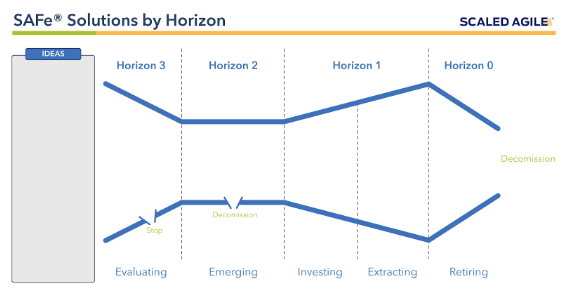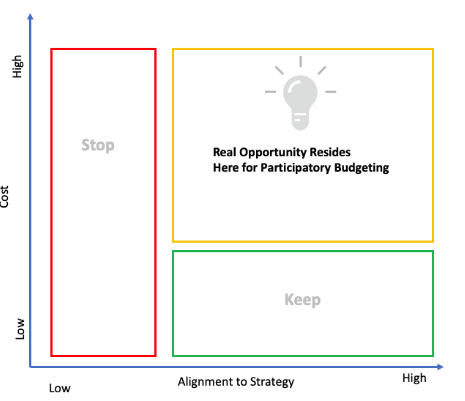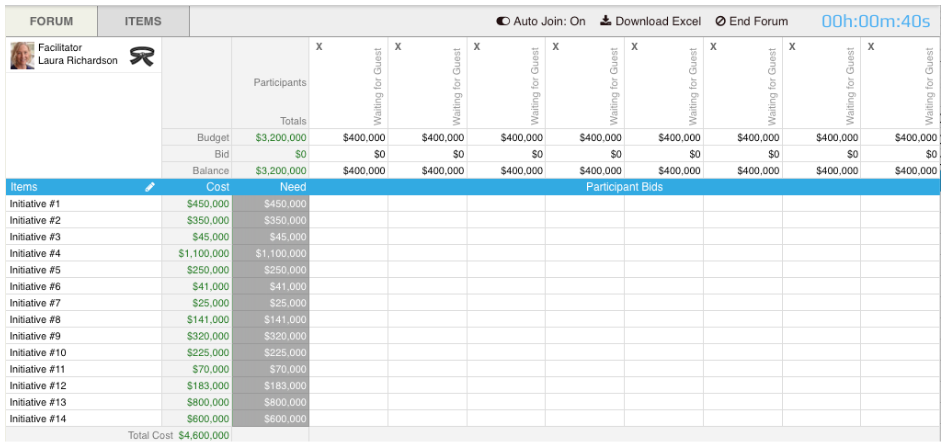Collaborative cost cutting leads to better long term decisions by incorporating information executives can’t easily access. Our experts provide three frameworks to prioritize objectives and investments.
The financial impact of the current pandemic is forcing many companies to reprioritize work and cut budgets. The traditional approach is to simply give executives a new budget target and make them responsible for hitting it, e.g.,“Every business unit must cut costs by 20%.” Because they must move quickly, they simply make the decision, often consulting only a few of their closest staff.
The mythic case for this approach is that it is faster to execute and easier to implement than collaborative approaches. After all, executives know what needs to be cut and they can make the necessary choices that meet the new budget requirements, right?
The reality is that while leaders can sometimes make non-collaborative decisions faster, the implementation/execution is vastly slower because the leaders have to explain, i.e., force, the workers to do their bidding. Moreover, executives fail to leverage the wisdom of their teams in identifying the most effective ways to realize the cost-cutting goals, resulting in cuts that do far more damage to legitimately needed costs while avoiding the “pet projects” that frontline workers know are unnecessary but often favored by executives for political or historical reasons.
The alternative approach, outlined here and supported by research from Gartner and PwC, is based on collaborative frameworks that promote engagement, transparency, and accountability at scale. Our experience is that using these frameworks ensures that the overall process is in fact faster, easier, and far more effective than their non-collaborative counterparts, precisely because employees are engaged in the process.
Benefits of Collaborative Cost Cutting
Approaching the cost management goal by casting a wide net has the following advantages:
1) It generates new insights from people who may not normally be part of these conversations. Most employees want to be part of the solution but are unsure how to help, and often the most novel and actionable ideas come from people who bring vastly different perspectives to the discussions.
2) It lays a foundation for alignment and support. When you include more people in the discussions, you create early alignment for the implementation of the decisions.
3) It improves the quality of the decisions made because it forces decisions through multiple review cycles.
Realizing the benefits is impossible using traditional techniques of surveys or simple discussion groups because they don’t provide the right form of support for engaging in complex, and often emotionally draining discussions.
The Applied Frameworks team has years of experience in using collaborative frameworks to support organizations in their cost-cutting initiatives. We share below our expertise using a core sequence of frameworks that you can use to collaboratively scale your own cost-cutting initiatives.
Step 1: Build Strategic Alignment
The first step to uncovering opportunities for cost management is to make all projects, programs or initiatives visible and comparable by organizing them according to the SAFe® Investment Horizons Framework. This framework from Scaled Agile, Inc., is based on the three horizons framework from The Alchemy of Growth by Mehrdad Baghai, Stephen Coley, and David White.
Leaders often assume that they already know all of the ongoing projects, motivating them to skip this step. However, in our experience people are only familiar with a subset of projects, and the attributes or mental model by which they might compare them are rarely the same for everyone. Moreover, many executives view projects based on their status instead of their value. Visualizing and aligning on the status of the portfolio before making changes is an essential step that ensures people are using the same comparison attributes and will significantly aid prioritization and decision making.
This framework uses the following structure:
- Horizon 3 – Evaluating. Initiatives in Horizon 3 typically include new product development, innovation projects and concept exploration. Review any projects that have not started, any that should be immediately stopped, and the current status of any underway investments.
- Horizon 2 – Emerging. Includes investments with successful hypothesis tests or Minimum Viable Products that have emerged from Horizon 3. Review any projects that should be immediately decommissioned and the status of promising new solution development.
- Horizon 1 – Profitable investments. Classify any work that requires significant ongoing investment as Investing. Classify any investments in stable solutions with a lower need for spending as Extracting.
- Finally, map solutions targeted for end-of-life in Horizon 0 – Retiring. Strongly consider accelerating retirement of any solutions that are consuming excessive budget.

Using the framework is deceptively simple: add every program or initiative to the framework by name and a very short description that includes a consistent set of details for portfolio decision making (such as projected future costs, revenue contributions, product manager, the teams or people working on these initiatives, and so forth.)
(Further details on using this framework, and the following two frameworks, are provided in the Appendix.)
Step 2: Uncover Waste at Scale
With an understanding of the current portfolio, the organization is now prepared to understand how existing projects may align to changed strategic priorities and which may be effectively cut or stopped to cut costs.
We accomplish this goal through the Strategic Alignment / Cost Matrix — a 2×2 framework that maps each initiative based on the degree to which it is aligned with strategic priorities and the expected future costs for completing its implementation.
Groups of leaders are assembled into forums where they identify which initiatives are not aligned with the strategy and are therefore candidates for cost reductions. By organizing leaders from different areas in a common forum, and by asking them to optimize the whole portfolio, we help them grow as leaders and minimize siloed thinking.
Note that in this analysis we assume a “positive intent,” which means that we accept, without question, that every project or initiative was approved for good reasons based on a different set of circumstances. This helps the team to avoid sunk costs and focus on the change needed for the future.
This step should be engaged with a broad number of managers, directors, senior directors, as well as architects or other key employees and stakeholders whose involvement ensures the broadest and richest set of data for decision making.

Assess each investment by remaining cost relative to the investment’s alignment to strategy and plot the investment on the matrix.
- Any investments with low alignment to strategy are candidates for immediate elimination, specifically any high cost investments.
- Keep any low cost investments closely aligned to strategy. Ideally no further discussion is required.
- Any investments in the yellow zone represent opportunities for deeper evaluation through participatory budgeting.
Step 3: Prioritize Investment
While the application of the Strategic Alignment/Cost matrix analysis will identify several candidates for cost-cutting, it will rarely identify enough projects that can be cut to meet the new budget targets. Accordingly, a final framework is needed to help the organization ensure that enough projects and initiatives are cut to meet the new budget targets.
The best framework for this step is Participatory Budgeting — a process in which a group of people decide how to allocate a shared budget. Commonly used in the public sector to allocate public funds, Participatory Budgeting (PB) can be used to help companies make tough budgeting decisions.
To illustrate the process, let’s say that the new budget was $3.2M and the application of the Strategic Alignment/Cost matrix resulted in fourteen remaining investments with a project total cost of $4.6M. This leaves a $1.4M shortfall that must be realized in additional cuts.
In a PB forum, participants are presented with the list of initiatives, the cost of each initiative, and the total available budget. The budget is divided equally among all participants, so that if there are 8 participants in the forum, each participant would receive $3.2M/8 = $400K.
As a group, the participants will decide where best to allocate their portion of the $3.2M. Because partially funded programs are not allowed, and will be cancelled, the group will soon realize they need to negotiate with each other to determine where to best apply funding. When employed at scale through multiple forums that engage many leaders, the winning investments most aligned with strategy will ultimately be funded.

When the groups are composed of people representing different roles and parts of the organization, people will find it hard to advocate only for projects that benefit them personally. They will very quickly realize that the only way to engage is to look at the investments from the lens of what is best for the organization as a whole.
The insights gained from understanding the impact of stopping or continuing any given investment, especially when the conversations center on comparing the merits of one initiative versus another, is how powerful insights are uncovered. Alignment is generated even when the outcome may result in canceled projects. Additionally, the results will better align to strategy and the process creates an appreciation for the merits of any decision taken.
Conclusion: Collaborative Cost Cutting Works
Making obvious budget adjustments may seem fast and easy. But using the concept of collaborative cost cutting gives leaders more insight as to all existing projects, programs and initiatives, lets them understand how existing projects may align to changed strategic priorities, and leads to the best allocation of resources. In essence, the cost cutting process is more successful if a wider net is cast and more voices are included.
Leveraging the set of collaborative frameworks in this article allows leaders to engage multiple levels of people across the organization to align on strategy, uncover waste at scale, and prioritize the most vital projects.
Want to Learn More about Collaborative Cost Cutting?
Watch Jason Tanner, CEO of Applied Frameworks, and Laura Richardson, SVP at Applied Frameworks, for the webinar, “The Case for Collaborative Cost Cutting,”. You can see the recording here.
Or, for advice, help or answers to your questions, you can also contact us directly.
APPENDIX: Framework Descriptions
| Framework name: |
Investment Horizons |
||
| Participants: | Executive, Leadership or Portfolio Management Team | ||
| Framework goal: | Participants align on comparison attributes and the current state of the portfolio by stages of products or projects and identify most important investments and opportunities for immediate savings. | ||
| Framework guidelines: |
|
||
| Boundaries provided: |
|
||
| Resources used: | List of all investments, remaining costs, expected value and accountable manager.
In-person: Whiteboard or wall, image of framework, large Post-It notes Online: Collaborative workspace (Miro, Mural, Weave) |
||
| Actionable outcome(s): |
|
||
| Framework name: |
Strategic Alignment/Cost Matrix |
||
| Participants: | Managers or Leaders of Product Development, Program or Project Teams
(For smaller organizations, all employees may participate) |
||
| Framework goal: | Organizational collaboration to identify optimal investments, investments requiring deeper analysis and further opportunities to stop investments. | ||
| Framework guidelines: |
|
||
| Boundaries provided: |
|
||
| Resources used: | Strategic goals and investments remaining from Investment Horizons framework
In-person: Whiteboard or wall, image of framework, large Post-It notes Online: Collaborative workspace (Miro, Mural, Weave) |
||
| Actionable outcome(s): |
|
||
| Framework name: |
Participatory Budgeting |
||
| Participants: | Ideally, all levels of organization including team members. | ||
| Framework goal: | Prioritization of remaining investments. | ||
| Framework guidelines: |
|
||
| Boundaries provided: |
|
||
| Resources used: | Investments remaining from Strategic Alignment/Cost matrix
Total actual budget In-person: Play money; Cards for investment name, estimated remaining costs, and potential value; name cards; grid for investments by row and columns by name. Online: Weave |
||
| Actionable outcome(s): |
|
||





